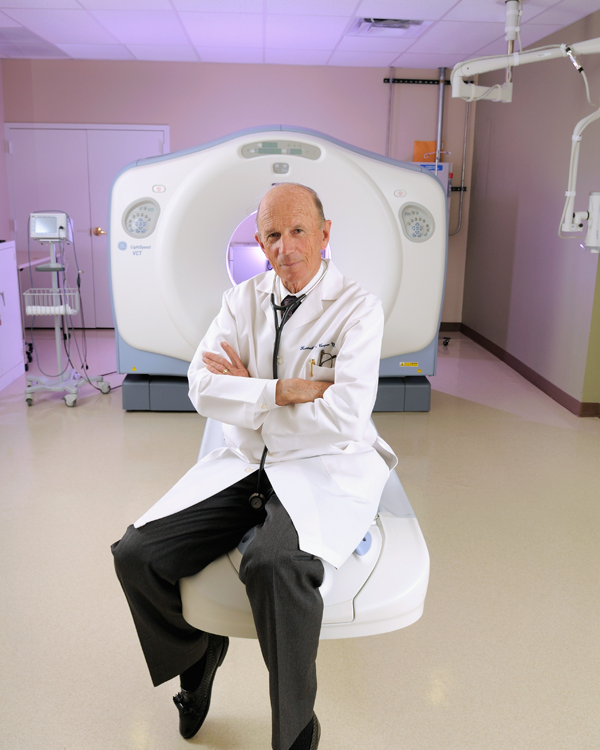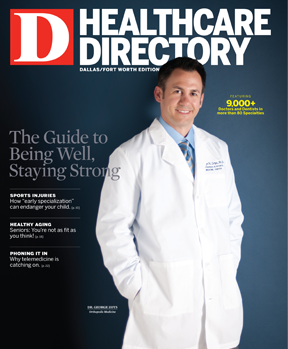Three out of four seniors say they are staying physically fit through exercise and that managing their health is important. Yet barely one out of the three say they are physically active daily, according to a 2012 National Council on Aging survey called United States of Aging. The survey included 2,250 adults 60 and older in Dallas and four other U.S. metropolitan areas.
“The mismatch between how people think the next 10 to 15 years is going to go and what current retirees experience is something that’s very consistent,” according to Jeff Goldsmith, a healthcare futurist and author of The Long Baby Boom: An Optimistic Vision for a Graying Generation. “There is no question that one distinguishing feature of our generation is this extraordinary, almost genetic optimism.”
As U.S. adults live longer, there is a growing emphasis on extending the quality—not just quantity—of life. That precisely is the first goal listed by the federal government’s Healthy People 2020 campaign, which seeks to minimize preventable disease, disability, injury, and premature death.
It’s also the sweet spot for The Cooper Institute and Cooper Clinic, both of which are located on a 30-acre North Dallas campus. Laura DeFina, MD, the institute’s interim chief scientific officer, is the author of two landmark studies in the past year on the importance of midlife fitness, based on Cooper’s enormous database. She said the institute, a nonprofit research and education organization, is honing in on “healthy aging, not just aging without disease and dysfunction. How do we globally promote healthy aging to get people off the couch?”
The institute has long focused on “compression of morbidity,” a concept developed by Stanford professor James Fries 30 years ago. He believed the same forces that lengthened life expectancy would also decrease—or compress—the number of years of disease and disability prior to death. In other words, the ideal healthy life would be one spent without impaired functioning right up until the moment of death.
Benjamin Willis, MD, who was a co-author of the Cooper studies, says the institute’s database allows researchers to have a unique window to fitness over a very long period of time. “There have been a lot of papers written about compression of morbidity,” Willis says. “It can be described, but it is hard to show it in data. We have been able to demonstrate it conclusively.”
People over 50 generally do not fear death as much as disability. When questioned, they express a dread of potential chronic illness, pain, and immobility. They fear senility, loss of memory, and dependence on others.
Shattering Illusions
Despite medical progress, the age of a first heart attack has remained relatively constant since the 1960s, and the incidence of several forms of cancer continued to increase until recently. High cholesterol and high blood pressure have decreased only because of successful pharmaceutical interventions.
These trends certainly shatter the illusion that each successive generation would live longer and healthier lives. It also does not bode well for the extra burden placed on age-based entitlement programs such as Medicare and Social Security.

In a study published last year in the Archives of Internal Medicine, researchers looked at data for more than 73,000 people in the Cooper Center Longitudinal Study database. They also looked at Medicare records for more than 18,600 of those from up to 46 years later.
The Cooper database contains more than 250,000 records from nearly 100,000 individuals representing more than 1.8 million person-years of observation. It’s one of the most highly referenced databases containing more than 3,000 variables, and is considered the world’s foremost repository of information on fitness. The data collection began with founder Dr. Kenneth Cooper’s first patient in December 1970.
Participants who were the most fit at age 30 through 59 had fewer chronic conditions after age 65. Those conditions included heart disease, diabetes, chronic kidney disease, Alzheimer’s disease, and certain cancers. Among men with the lowest fifth of fitness scores, the annual rate of chronic-disease prevalence was 28 percent, compared with 16 percent for the fittest one-fifth. The corresponding numbers for women were 20 percent, compared with 11 percent. The effect continued until the end of life, with fitter individuals having fewer chronic conditions in the last five years of life.
This study was followed by another, which found that healthy living in middle age can add more than a decade of heart attack-free living to old age. According to the study’s author, those with optimal risk factor profiles at age 45 lived about 14 years longer free of total cardiovascular disease compared with those with at least two major risk factors in middle age.
For older Americans, that is the ultimate payoff. After six months of exercising, the satisfaction of a well-functioning body trumps appearance—especially for men, according to research by a Baylor University health professor.
After age 40, people typically lose at least 8 percent of their muscle mass every 10 years, a process that accelerates significantly after age 70. Without exercise, that lessens strength, mobility, and independence. Experts encourage older exercisers to include endurance activities, strength training, balance exercises and stretching in their workout routines.






